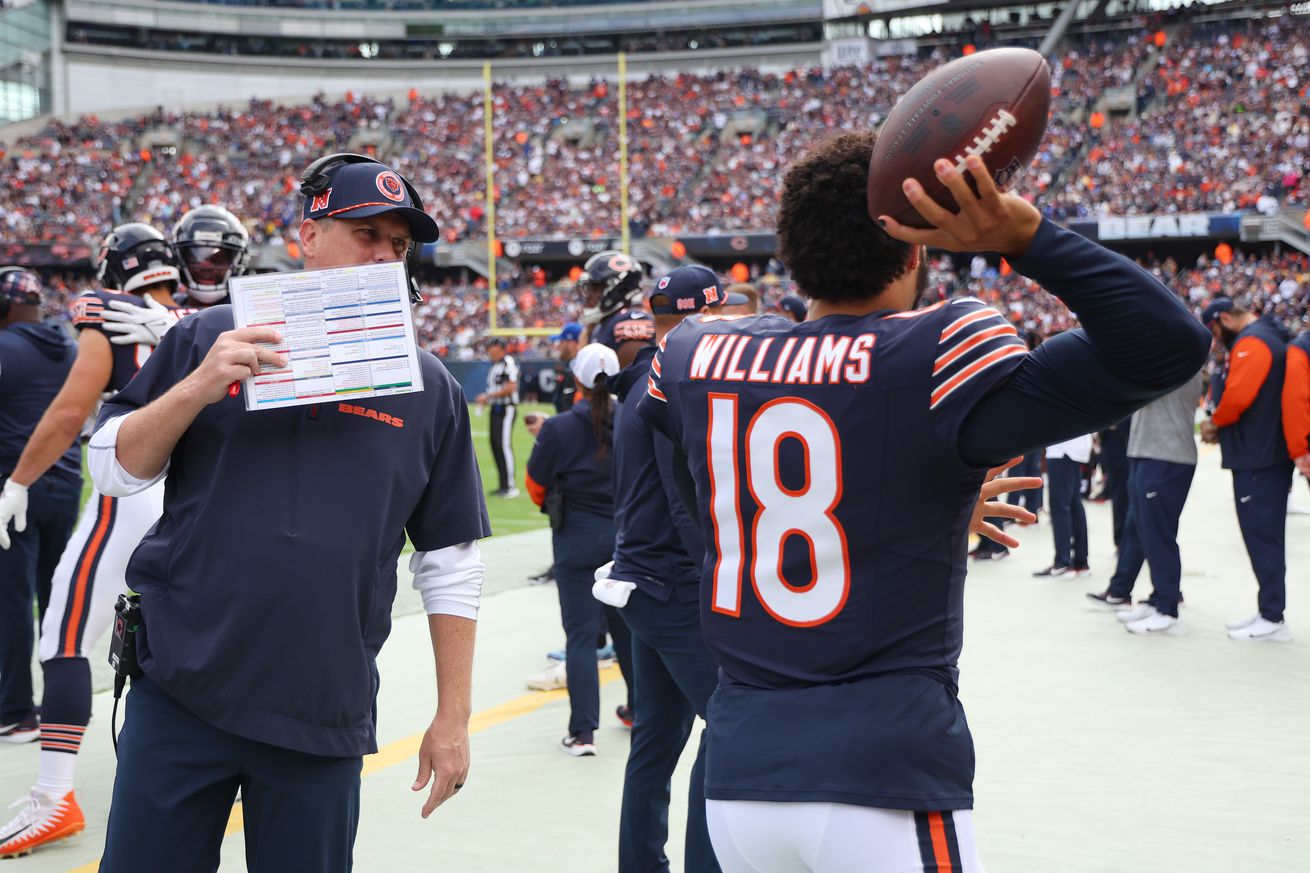
Earlier this offseason, I did an in-depth series exploring Caleb Williams’ rookie season and found that he especially struggled in two main areas: he was extremely inaccurate when passing downfield and took way too many sacks.
Neither of these should be much of a surprise to fans who watched Bears games last year, but what I want to explore today is how those struggles may or may not translate to 2025.
Deep passing
I’ll start with deep passes, which went at least 20 yards downfield. Williams was truly awful here, as you can see in the table below, where Williams is compared to all 48 rookie QBs to attempt 250+ passes since 2010 (all data from PFF). Ranks in the top 25% are highlighted in green, while those in the bottom 25% are in red.
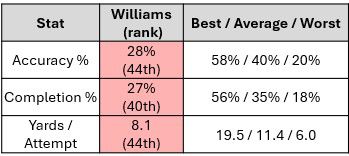
That’s not pretty – Williams was one of the worst deep passing rookies the NFL has seen in the last 15 years.
Now the real question for today: does that mean Williams is likely going to be a terrible deep passer for his NFL career?
To begin exploring that, I looked at how that same QB sample did on deep passes in year 2. Actually, the sample shrunk a little here: only 37 of the QBs also attempted 250+ passes in their sophomore campaign, so I looked at their deep passing performances for each year to see if there was any predictive value. The graphs below show the year 1 vs. year 2 comparison for a variety of deep passing stats.
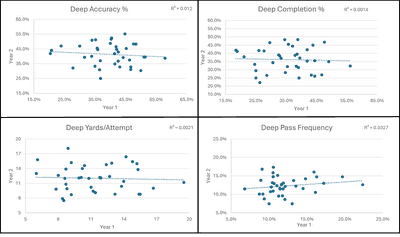
As you can see, there’s essentially no relationship between year 1 and year 2 deep passes in accuracy, completion percentage, yards/attempt, or even how often QBs throw the ball deep.
That should be fairly obvious visually, but I also tried to put a line through the data and get an R2 value, which tells you how well that line fits the data on a scale from 0-1. Numbers closer to 1 mean there is a stronger relationship, and all of these are less than 0.05, telling you that year 1 deep passing has essentially no impact on year 2.
That’s extremely good news for Bears fans – Williams was terrible throwing deep in 2024, but he’s just as likely to be good at it in 2025 as anybody else.
For a little anecdotal evidence, the QBs most similar to Williams in deep passing as a rookie were Blaine Gabbert, Brandon Weeden, Blake Bortles, Derek Carr, Marcus Mariota, Joe Burrow, and Trevor Lawrence. While that list includes several busts, it also includes long-term starters and even a top-tier passer in Burrow. In short, the full range of career outcomes was still in play for these QBs who struggled throwing deep as rookies, just as it is for Williams.
Medium Passing
Let’s take the same look now at medium passing (10-19 yards downfield), where Williams was also bad as a rookie. The table below shows how he fared on these passes compared to the same sample of 48 rookies with 250+ pass attempts since 2010.
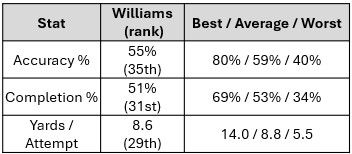
Here we can see that Williams was bad but not as terrible relative to his peers. He was solidly sub-average here but not one of the worst. Will that translate to 2025? Let’s look at the same year 1 vs. year 2 graphs we did above for deep passing to find out.
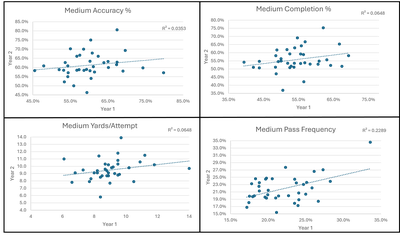
Once again, we see basically no relationship in pass effectiveness, with R2 values of 0.06 or less for accuracy, completion percentage, and yards/attempt. Pass frequency has a slightly stronger relationship, and this one is interesting to me because Williams threw to the medium area of the field less than 18% of the time, well below the sample average of 24% of passes and the 7th lowest mark in the sample. I have a hunch that might change in a new offense, but history suggests it has a chance of carrying forward a bit.
Again, anecdotally, the QBs most similar to Williams in medium passing were Sam Bradford, Andy Dalton, EJ Manuel, Blake Bortles, Josh Allen, Kyler Murray, and Baker Mayfield. This is still a wide spectrum from bust to MVP, adding further evidence to the idea that Williams struggling here as a rookie is not anything to worry about.
Sacks
Finally, let’s look at Williams’ other main weakness: he took way too many sacks. The table below shows how Williams’ sack rate (how many of his dropbacks turned into sacks) and pressure to sack rate (how many of his pressures turned into sacks) compared to the 48 QB sample of rookies with 250+ passes since 2010. All ranks in top 25% are highlighted in green, while those in the bottom 25% are red.
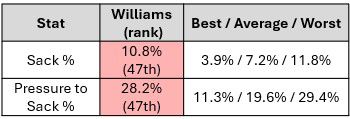
Just like with deep passing, Williams was atrocious here, ranking as the 2nd worst rookie in the last 15 years both in sack rate and pressure to sack rate.
How does that translate to year 2? Let’s check the data.

For overall sack rate, there appears to be some sort of relationship, but it’s fairly weak, with an R2 value of only 0.18. That means there’s more year-to-year correlation than any of the medium or deep passing, but still plenty of variance.
The really good news for Chicago Bears fans is that pressure to sack rate has basically no relationship from one year to the next. If Caleb improves here, which seems likely, his sack rate will naturally drop, and that’s before factoring in upgrades in the offensive line and overall offensive scheme that should lead to him being pressured less frequently in 2025.
Still, sacks are the single biggest reason to be worried about Caleb Williams’ long-term NFL outlook at this point. Anecdotal evidence across this sample backs that up, as the QBs most similar to Williams in sack rate and pressure to sack rate as rookies are Blake Bortles, Bryce Young, Zach Wilson, Justin Fields, Josh Rosen, Kyler Murray, Marcus Mariota, and Jimmy Clausen. There are a lot of busts on that list, only 1-2 long-term starters (depending on how Bryce Young turns out), and no MVP-caliber players.
Do any strengths translate?
It wasn’t all bad for Williams in his rookie season though, so now I want to take a minute to look at two of his strengths and see what those portend about 2025.
Short Passing
Williams was quite a good short passer (0-9 yards downfield) in his rookie season, as you can see in the table below. Once again, Williams is compared to 48 rookies with 250+ passing attempts since 2010, and categories in the top 25% are highlighted in green while the bottom 25% are highlighted in red.
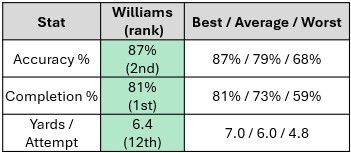
As you can see, Williams was outstanding here. He ranked 2nd among the 48 rookies in accuracy, 1st in completion percentage, and 12th in yards per attempt. Will that translate to his sophomore campaign in 2025?
Given that we just found deep and medium passing doesn’t translate, it’s fair to hypothesize that short passing won’t either, but it’s still worth looking into due to a larger volume of passes. The average QB throws about 49% of their passes short compared to a combined 35% across deep and medium passes. The larger sample size could mean it is more consistent year over year. To find out, I once again looked at efficiency metrics in year 1 vs. year 2 for the 37 QBs with 250+ passes in both of their first 2 seasons, shown in the figure below.
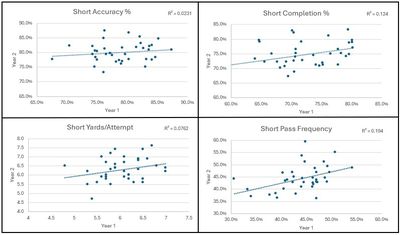
Unfortunately, we see that there is not much relationship between short passing effectiveness in year 1 and year 2. You can see that visually on the graphs, and the R2 values are once again extremely low. There’s a weak relationship (R2 = 0.19) between how frequently a QB throws short in year 1 and year 2, but that’s more of a play style than effectiveness measurement. For what it’s worth, Williams threw only 41% of his passes short as a rookie, which was on the lower side of the sample (37th).
Williams was quite good throwing short as a rookie, but that doesn’t mean he will necessarily repeat that success in 2025. To illustrate this anecdotally, the most similar short passers to Williams were Russell Wilson, Joe Burrow, Jayden Daniels, Mac Jones, Tua Tagovailoa, and Kyler Murray. That’s mostly a pretty good list of company to be in, though only Joe Burrow has consistently been a top-level QB and Mac Jones didn’t turn out to be a starter.
INT avoidance
Finally, let’s look at one other area where Williams excelled as a rookie: avoiding interceptions. Williams threw only 6 picks on 562 passes, good for an interception on only 1.1% of passes. That was the 3rd lowest of the 48-QB sample, and less than half of the average of 2.5%.
You probably won’t be surprised to hear that this doesn’t necessarily translate to year 2 either, as we can see in the chart below.
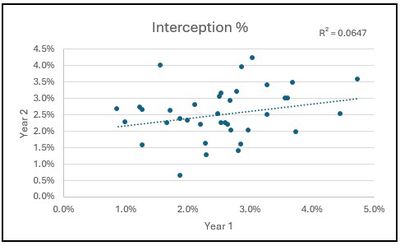
Once again, we see very little relationship between performance in year 1 and year 2. This means Williams is likely to regress to the mean some in 2025 and throw interceptions at a higher rate.
And once again, we see a mixed bag of performers similar to Williams, as the other QBs who avoided interceptions most effectively in their rookie seasons are a mix of quality starters (CJ Stroud, Dak Prescott, Joe Burrow) and backups (Robert Griffin III, Gardner Minshew).
Lessons Learned
Overall, not much of a QB’s rookie season predicts what they’ll do in year 2. The only real exceptions were how frequently QBs targeted different depths of the field and how often they took sacks, and even those were weak relationships. This matches what PFF found in a 2020 study: “We find that rookie performance is less predictive than performance in later years and that draft status still plays a huge role when projecting QBs going into Year 2.”
That 2nd part is particularly interesting to me. Even though he had a mediocre rookie season, Caleb Williams still has a strong career projection simply because he was the #1 overall pick in the draft. Those QBs, by and large, tend to be pretty good players, so Williams is likely going to be good. It doesn’t matter that he took a ton of sacks and struggled throwing downfield in year 1; we don’t have to be concerned about that until it happens again in 2025.
